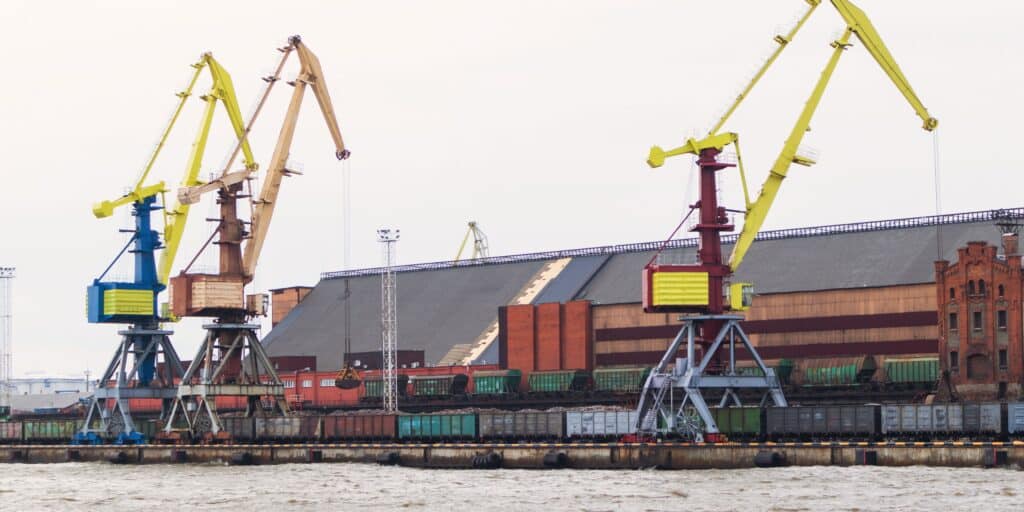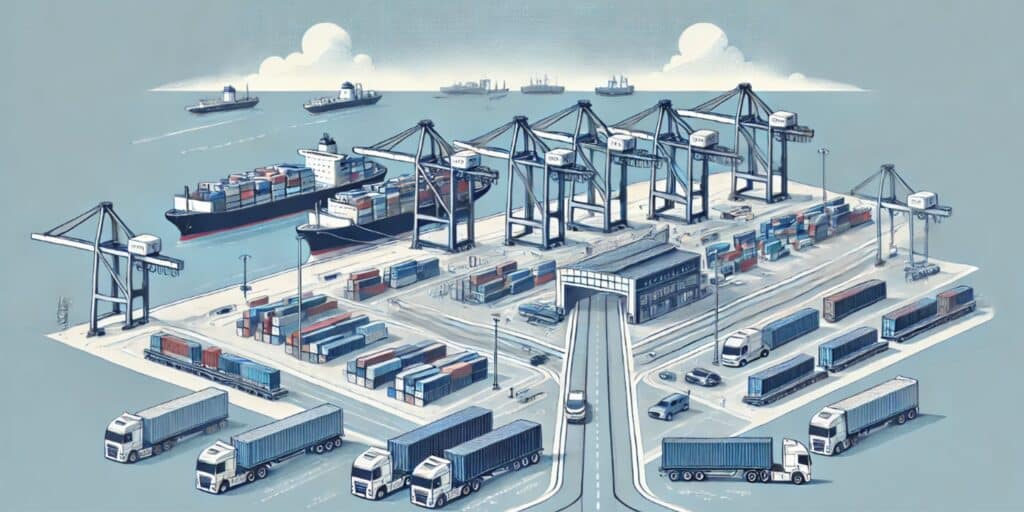When vessels don’t sail directly to their final destination, their cargo is transferred to strategic ports where another ship continues the journey. These ports, known as transshipment hubs, serve as critical interchange points in global shipping, facilitating seamless cargo movement between major trade routes and optimizing supply chain efficiency.
While there are many cargo redistribution centers, a few stand out as the largest and most influential in global trade, handling more than 50% of all global transshipment cargo. What is a transshipment hub, and which ports are the world’s leading centers for cargo transfer and global trade?
Role of Transshipment Ports in Global Shipping
The concept traces back to ancient trade routes, where merchants relied on strategic ports to transfer goods. Historic ports like Alexandria (Egypt) and Malacca (Malaysia) functioned as early cargo redistribution centers, facilitating the unloading, storing, and transferring of goods onto other vessels for onward trade.
Definition and its function in global shipping
A transshipment hub is a strategic port where cargo containers are temporarily unloaded, transferred, and reloaded onto another vessel for onward transport to their destination. These hubs serve as crucial interchange points in global shipping, optimizing cargo movement across different trade routes.
How Does a Transshipment Hub Operate?
Cargo Dispatch from Origin: Containers are initially shipped from their point of origin but may not have a direct route to their delivery point.
Arrival at the Transshipment Hub: Instead of continuing directly, the cargo arrives at a transshipment hub, where it is temporarily stored and sorted.
Transfer to Another Vessel: Containers are then loaded onto different vessels scheduled to continue the journey to the destination port.
Final Delivery: The cargo reaches its designated destination, completing the transshipment process.
Their significance in the maritime logistics network
Just as major airports serve as key transfer points for passengers traveling between different destinations, transshipment hubs function as central exchange points for cargo containers in the maritime logistics network. They allow ports to connect to the worldwide shipping system without requiring direct services for every location, optimizing both cost and transit times. In the hub-and-spoke system, smaller feeder vessels transport cargo to a central hub, where larger deep-sea container ships take it to distant destinations, improving connectivity between regional and global networks.
Harbors like Jamaica’s Kingston and Italy’s Gioia Tauro serve as key transshipment and consolidation points. Some hubs serve as key intersections of major shipping routes, enabling seamless cargo transfers between long-distance sea lanes at strategic chokepoints like Singapore and Spain’s Algeciras. Others function as relay transshipment hubs, where cargo is transferred between ships operating along the same maritime region but serving different ports. This model, seen in ports like Salalah in Oman and Tanjung Pelepas in Malaysia, provides flexibility in distribution and enhances trade efficiency.
Factors that contribute to a port's status as a transshipment hub
A port’s ability to function as a transshipment hub depends on several critical factors that enhance its efficiency and competitiveness. Here are the factors that contribute to a port’s status as a transshipment hub:
Strategic Location
Hubs positioned along major trade routes, such as Hong Kong, play a vital role in freight transfers. Their proximity to busy shipping lanes allows vessels to make quick stops, reducing transit times and costs.
Infrastructure
Advanced port facilities, including deep-water access and automated handling systems, ensure smooth transportation operations. Many ports in China have heavily invested in modern terminals to strengthen their transshipment capabilities.
Connectivity
Efficient rail, road, and maritime links improve intermodal transfers, making hubs more attractive for transshipment. Strong regional and international connections increase a port’s handling capacity.
Operational Efficiency
Technology-driven solutions and optimized logistics boost a hub’s ability to process shipments quickly. Ports excelling in efficiency, like Singapore, dominate international trade.
Top Transshipment Ports in the World
The volume of shipments handled by container vessels has been steadily rising in recent years. According to recent data, ports across Asia, particularly in China, are playing a growing role in the industry. Let’s explore the top transport hubs that drive global business today.
Port of Singapore
When it comes to global transshipment hubs, the Port of Singapore stands out as one of the busiest and most strategically significant. It handles millions of TEUs annually, accounting for 20% of the world’s transshipment traffic.
In 2019, it processed 37.2 million TEUs, with 30.9 million dedicated to transshipment, making it the second busiest port by overall TEU volume. Singapore’s port connects to 600 ports in 123 countries, with 130,000 vessels calling each year. Looking ahead, the development of Tuas Port, expected to handle 60 million TEUs by 2040, will further cement Singapore’s position as a top maritime hub.
Port of Shanghai
The Port of Shanghai remains one of the busiest in the world, with a container throughput of 49 million TEUs in 2023, maintaining its number-one ranking globally for 14 consecutive years. It serves as a vital gateway for trade, connecting to over 700 ports across 200+ countries and regions, with more than 320 weekly deliveries.
Shanghai has also embraced sustainability, becoming one of the first ports to offer liquefied natural gas bunkering and partnering with the Port of Los Angeles to establish a trans-Pacific green shipping corridor. As noted in various industry journals, Shanghai’s advancements in infrastructure and technology have solidified its influence in maritime trade. Additionally, its seamless integration with air transportation networks enhances efficiency, making it a key player in shipment and business operations.
Port of Rotterdam
Spanning 40 kilometers in length and 10 kilometers in width, this key European port plays a vital role in global transportation. Port of Rotterdam welcomes around 30,000 oceangoing ships and 130,000 river ships annually, ensuring a seamless flow of goods across continents.
Covering 10,500 hectares, including 2,000 hectares of basins, it offers extensive space for warehousing and industrial activities. In 2022, it managed 467 million tons of freight, with container traffic reaching 14.4 million TEUs. Ranked as the world’s fifth-largest bulk port and the tenth-largest container facility, it continues to expand, adapting to growing demands. Over the years, development has extended downstream, reflecting continuous modernization.
Impacts on Global Trade
Around 90% of international commerce depends on water transport, but direct routes to destination ports are not always feasible. Transshipment hubs are important in bridging these gaps, ensuring efficient freight movement across interconnected shipping networks.
How they optimize global commerce
Early trade routes relied on natural harbors and manual unloading, but industrial advancements led to specialized ports designed for faster transfers. Today, modern ports use automation, deep-water terminals, and extensive connectivity to handle massive freight volumes with precision.
Exploring cost savings:
One way transshipment ports reduce expenses is by consolidating shipments. Instead of multiple smaller shipments traveling separately, goods are combined onto larger carriers, cutting costs for businesses. For example, the Port of Singapore processes millions of TEUs annually, allowing companies to benefit from economies of scale.
Trade facilitation:
Transshipment ports simplify customs procedures and optimize transit times, ensuring smoother movement of goods. The Port of Rotterdam, with its advanced digital tracking systems, enables rapid clearance, minimizing delays.
Supply chain efficiency:
By acting as key transfer points, transshipment ports reduce bottlenecks and enhance distribution networks. Shanghai, which connects to over 700 ports, ensures seamless freight movement across continents, strengthening supply chain reliability.

Future trends in transshipment and global shipping
The shipping industry has rapidly embraced innovation, making it more efficient, sustainable, and adaptable to evolving market demands. As transshipment ports integrate smart technologies and eco-friendly initiatives, they are setting new standards for connectivity and environmental responsibility.
Technological Advancements: Cutting-edge digital systems are enhancing efficiency in freight transfers. Blockchain, AI-powered analytics, and IoT (Internet of Things) sensors are improving tracking and security.
Automation: Automated cranes, self-navigating ships, and AI-driven scheduling are reducing human intervention while boosting speed and accuracy.
Sustainability Initiatives: Ports are shifting to greener energy sources and eco-friendly infrastructure.
Sinay’s Data-Driven Solutions for Maritime Optimization
As a specialist in data collection and real-time monitoring, our company enhances maritime operations and reduces delays at transshipment hubs through advanced technology and analytics.
Metocean Analytics: Improving Offshore Operations
Our tools help businesses minimize risks and improve accuracy in offshore projects. Using hindcast data, we analyze weather patterns, delivering detailed reports on wind, waves, currents, water levels, salinity, and temperature. These insights reduce disruptions, cut downtime, and ensure project stability.
Safecube: Smarter Container Tracking
Is your company ready for seamless end-to-end container tracking? Our platform provides full visibility into multimodal flows with precise geolocation and interactive mapping. With a database of over 80 million containers and 180 shipping lines, we create tailored container lists to meet your needs.
Data Collection: Enhancing Maritime Monitoring
With over a decade of experience, we deliver accurate maritime data for environmental monitoring and project analysis. Our real-time monitoring, field studies, and preventive measures minimize impact, while independent data collection ensures reliability.
PAM: Advancing Marine Conservation
We use Passive Acoustic Monitoring (PAM) to detect marine mammals and measure underwater noise, assessing the impact of shipping and construction. Our hydrophones capture human-made and natural sounds, providing real-time data for noise management and environmental compliance.
The primary reason for utilizing transshipment hubs is to enhance efficiency and expand the geographical reach of maritime container shipping networks. They also facilitate route flexibility, enabling carriers to adapt to shifting trade patterns and market demands. As global trade continues to evolve, the role of transshipment hubs will remain crucial in ensuring the resilience and sustainability of container shipping networks.
A transshipment hub is a major port where cargo is temporarily stored and transferred between vessels before reaching its final destination. These hubs serve as strategic connection points in global shipping, allowing large container ships to offload goods that are then reloaded onto smaller feeder vessels for regional distribution.
Transshipment hubs improve shipping efficiency by consolidating cargo, optimizing routes, and reducing costs. They enable large vessels to bypass smaller ports with limited capacity, ensuring faster and more cost-effective distribution of goods worldwide. These hubs also play a crucial role in handling growing trade volumes and reducing congestion in key shipping lanes.
Leading transshipment hubs have deep-water access, advanced terminal facilities, high container-handling efficiency, and strong connectivity to global shipping routes. Strategic location, modern infrastructure, and partnerships with major shipping lines are also key factors that contribute to a port’s success as a transshipment hub.
Some of the busiest transshipment hubs include:
- Port of Singapore – One of the world’s largest and most efficient transshipment ports, handling millions of TEUs (Twenty-foot Equivalent Units) annually.
- Port of Shanghai – A key global hub with extensive connections to international markets.
- Port of Hong Kong – A vital gateway for trade in Asia, known for its high container throughput.
- Port of Rotterdam – Europe’s largest transshipment hub, connecting global trade routes.
- Port of Dubai (Jebel Ali) – The biggest port in the Middle East, serving as a critical link between Asia, Europe, and Africa.



